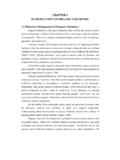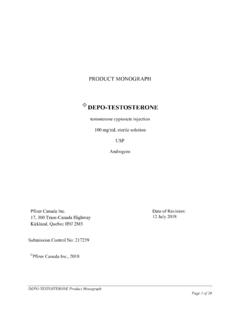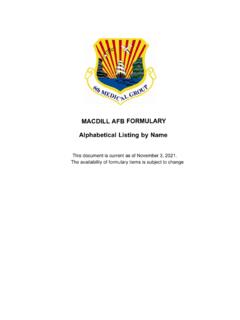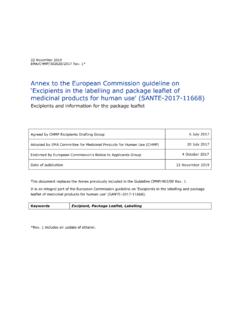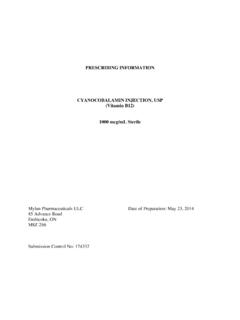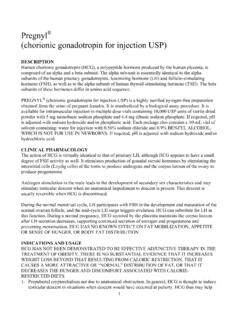Transcription of CHAPTER 7 ALCOHOLS, THIOLS, PHENOLS, ETHERS
1 CHAPTER 7 alcohols , THIOLS, PHENOLS, ETHERS Several new functional groups are presented in this CHAPTER . All of thefunctions are based on oxygen and sulfur in the sp2 hybridized state. Thefunctional groups contain two pairs of non-bonding electrons and are thecornerstone of many organic processes. The structures for alcohols , phenols, thiols, ETHERS and thioethers are shown NomenclaturePriorities in nomenclatureSeveral functional groups have been encountered as we have advancedthrough the chapters. When a new functional group is presented, its nomenclatureis always based on the parent name with an ending that designates the functionalgroup. When several functional groups are present in a molecule, priority rulesmust be used to determine which function is the parent system that determines thenumbering of the system and the suffix used in the final priority list is as follows:carboxylic acids > aldehydes> ketones> alcohols > amines > alkene > alkyne> alkyl, halogen, nitroThus a compound that contained hydroxy, alkene and ketone functionswould be named as a ketone with the ketone getting the lowest number possible, andsubstituents are numbered accordingly and named in alphabetical the compound on the left is named as an alcohol, but the one on theright is named as a ketone even though both compounds have the seven carbonbackbone.
2 124 Ch 7 alcohols , Thiols, Phenols, EthersOHOCl1-chloro-6-hydroxy-4-hepten-3 -oneOHCl7-chloro-3-hepten-2-olOH has priorityketone has priorityAlcohol NomenclatureHydroxy compounds are encountered frequently in organic chemistry andthe OH function is of high priority with only acids, aldehydes and ketones havinghigher priority. Thus many compounds have the alcohol parent IUPAC system names the longest chain hydrocarbon as the parent,drops the ending -e and adds a new ending of -ol. The alcohol has a higher priorityin nomenclature than alkenes, alkynes, alkyl groups and halogen and is given anumber lower than any of those groups. Once the parent compound is identifiedand the location of the alcohol function is specified, other functions are named inalphabetical IUPAC and common names for several alcohols are given alcoholethyl alcoholn-propyl alcoholisopropyl alcoholtert-butyl alcoholmethanolethanol1-propanol2-propan ol2-methyl-2-propanolStructureCommon Thiols 125CH3 CHCH2 OHCH3CH3 CHCH2CH3 OHCH3CH2CH2CH2 OHCH2 OHOH cyclohexyl alcoholn-butyl alcoholsec-butyl alcoholisobutyl alcoholbenzyl alcohol1-butanol2-butanol3-methyl-1-prop anolcyclohexanolphenylmethanolWhen more than one hydroxyl group is present, the IUPAC system usesnumbers to designate the location of the hydroxyls along with a prefix di, tri, todenote the number of hydroxyls.
3 Some systems with more than one hydroxyl havecommon names as ,2-ethandiolethylene glycol1,2,3-propantriolglycerol1,2-cyclo hexandiolOHAliphatic alcohols are classified as primary, secondary or tertiary, accordingto the type of carbon atom attached to the alcohol function. If the carbon attachedcarries one alkyl group, the alcohol is primary. With two alkyl groups attached tothe carbon the alcohol is secondary, and three alkyl groups attached the alcohol 'RCOHR'R'' Physical Properties of AlcoholsMany of the physical properties of alcohols are directly related to thehydrogen bonding exhibited by the hydroxyl group. In pure alcohol systems, extra 126 Ch 7 alcohols , Thiols, Phenols, Ethersenergy must be added in order to cause the sample to boil, thus high boiling pointsare observed. Also, alcohols form hydrogen bonds withwater and as a result are very soluble in water unlessmore than six carbon atoms are boiling points of alcohols as a result of hydrogen bonding aredemonstrated in the examples given below.
4 The hydrocarbon of closest mass isshown below each alcohol. The difference in boiling points is as much as 153 obecause of the hydrogen bonding is exceptionally important in biological function. Manymolecules that are active in biological processes have the OH function the molecule is in a living system it must interact with a protein. Theinteraction must have a specific fit as to the shape and stereochemistry of the proteinand the molecule, and much of the intermolecular attraction comes from hydrogenbonding from the hydroxyls of the molecule to oxygen and nitrogen sites present inthe protein as shown below for pyridoxine, vitamin B6 interacting with a B6(grains, milk, eggs)protein receptor Thiols Naturally Occurring AlcoholsThe R-OH function is truly abundant in nature. All carbohydrates, alsocalled sugars, are compounds that contain the alcohol function.
5 A few commoncompounds are listed below. Both citronellol and geraniol are found in plants andtrees and belong to a family of compounds called terpenes. They are used as blendsin perfumes and spices. Citronellol is used in candles to help repel , a carbohydrate, is a compound found in food sources and isimportant in healthy metabolism. Theaflavine found in black tea, contains bothaliphatic and aromatic hydroxyl functions and ether black tea possible cell growth factorMeso-inositol(fruits, vegetables, meats) Preparation of alcohols 128 Ch 7 alcohols , Thiols, Phenols, EthersSeveral of the low molecular mass alcohols are prepared on an industrialscale that produces millions of tons. The alcohols areused throughout the chemical and academic world,commercially as solvents, as medicinal preparations, and in alcoholic drinks(ethanol)Methanol is produced in a special process that involves catalytichydrogenation of carbon monoxide.
6 Methanol is extremely toxic and causesblindness when temp and pressBoth ethyl alcohol and isopropyl alcohol are synthesized by acid-catalyzedaddition of water to ethylene and propylene is also produced as a supplement for auto fuels by fermentation ofthe carbohydrates found in grain. The process gives ethanol that contains 5% waterafter distillation. The water is removed by reaction with lime, calcium oxide. Grignard Reactions with Carbonyl CompoundsGrignard reagents were introduced in the halogen CHAPTER . Their use is sovaluable and general in organic chemistry that their reactions will be shownthroughout many chapters. The example shown below could be expanded into manyvariations just by changing the halide and the carbonyl compound. Variations withother types of organometallic compounds are also available. Thiols 129CH3CH2Br Mgdiethyl etherCH3CH2 MgBr ether complexOCH3CH2 MgBr 1)2)H3 OOHCH2CH3++There are many examples of the use of Grignard reactions.
7 The exampleabove could be expanded into many variations just by changing the halide and thecarbonyl compound. Variations with other types of organometallic compound arealso available. The reaction is given in more detail in CHAPTER 8 on aldehydes andketones. Hydration of AlkenesThe reactions shown to prepare ethanol and isopropyl alcohol industriallyare examples of electrophilic addition of water to an alkene. The preparation ofhigher molecular weight alcohols by hydration is not as important becauserearrangements occur and product yields are provides alcohols from alkenes under mildconditions without rearrangement. Mercuric acetate reacts with the alkene to form acyclic mercurinium ion with a positive charge. Water attacks the intermediate fromthe carbon with the highest positive charge, the tertiary carbon here, and from thebackside of the mercury atom. Water and mercury will be anti in an intermediateproduct which is not isolated, but it is reacted with sodium borohydride to convertthe carbon-mercury bond into a carbon-hydrogen bond.
8 The final result is theproduction of the alcohol at the most substituted carbon of the alkene, theMarkovnikov (OAc)2H2 OHgOAcOAcHgOAcH2O+H+NaBH4+++ 130 Ch 7 alcohols , Thiols, Phenols, EthersAlkenes react with borane, BH3 ether, by syn-addition of hydrogen andboron to the alkene. The boron atom adds to the least substituted carbon three alkene units have added the intermediate is treated with basic hydrogenperoxide to form the alcohol. The process is called hydroboration-oxidation. Theprocess provides the alcohol with anti-Markovnikov of HaloalkanesHalogenated alkanes can be converted to alcohols by reactions described inchapter 5 on Nucleophilic Substitution and Elimination. The main points ofreactions of alkyl halides are that the primary halides react by SN2 and E2 reactions,while secondary and tertiary substrates react primarily by SN1, E1 and E2 reactions. Results are shown for reactions of primary and tertiary halides with hydroxide,which is both a good nucleophile and strong +++++Reactions of the same substrates with water (or water in a solvent), which isCH3CH3H3 CCH3CH3 OHBH3BH2O2OH33 Thiols 131very non-nucleophilic and non-basic, show only SN1 and E1 processes with thetertiary ReactionSN1 Reduction of Acids, Esters, Aldehydes and KetonesThe carbonyl group of several functional groups may be converted to thealcohol by reducing agents.
9 The reduction of a carboxylic acid with lithiumaluminum hydride and the reduction of a ketone with sodium borohydride areshown below. Both reactions exemplify very common and reliable reactions are given in detail in the aldehyde and ketone CHAPTER )2)OOHNaBH4H3O1)2) Oxidation of Alkenes to Vicinal DiolsCompounds with hydroxyl groups on adjacent carbons are called vicinaldiols. Oxidation of alkenes with cold KMnO4 or OsO4 provides occurs with synaddition and provides cis vicinal diols. Trans vicinal diols can be prepared by ringopening of an oxirane, a three-membered ring containing oxygen. 132 Ch 7 alcohols , Thiols, Phenols, Reactions of AlcoholsAcidic properties of alcoholsThe high electronegativity of the oxygen atom in alcohols causes the oxygento take electrons away from the hydrogen atom. The OH bond is polarized and isable to give up a proton, H+. Thus alcohols are weak acids, but can becomestronger acids depending on the types of organic substituents R-OHThe ionization constant for the above equilibrium is given by Ka = [RO-][H+] / [ROH].
10 Acidity is often expressed as pKa which is the negativelogarithm of the Ka. Thus, pKa = -log Ka . The pKa is shown below for severalalcohols. Electron donating groups weaken the acidity (higher pKa) while electronattracting groups strengthen the acidity (lower pKa). Phenol, the last entry,represents a very acidic class of organic compounds and is presented later in acidic property of alcohols is important as it permits the formation ofalcoholate salts, called alkoxides. Alkoxides are useful both as strong bases and asgood nucleophiles for SN2 reactions. Alkali metals and other very strong bases canbe used to generate the Thiols 133 Conversion of alcohols to Alkyl Halides Reaction with Hydrogen HalidesAliphatic alcohols react with hydrogen halides to produce alkyl = Cl, Br, IThe mechanism of the reaction depends on the structure of the alcohol, butthe first step always involves protonation of the alcohol to form an oxonium ionThe +OH2 group is an excellent leaving group as it forms a neutralmolecule of water.
